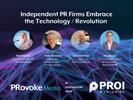Paul Holmes 01 Dec 2002 // 12:00AM GMT
 “Advertising is the wind,” say Al Ries and Laura Ries in their new book, The Fall of Advertising and the Rise of PR. “Public relations is the sun.”
“Advertising is the wind,” say Al Ries and Laura Ries in their new book, The Fall of Advertising and the Rise of PR. “Public relations is the sun.”
They are drawing an analogy from one of Aesop’s fables, in which the wind and the sun argue over which is the most powerful. To settle the dispute, they decide to hold a competition to see which one of them can force a traveler to take off his coat. The harder the wind tries to blow the coat off, the more tightly the traveler pulls it about him, but as soon as the sun starts to shine the traveler removes it voluntarily.
The moral of the story: “The harder an advertisement tries to force its way into the mind, the less likely it will accomplish its objective.”
That’s just one reason advertising is destined to be replaced by public relations as the lead brand-building discipline, according to the authors, who also have fun lampooning what passes for creativity in the advertising industry, and lambasting companies that spend billions of dollars on ad campaigns for little or no tangible result.
It seems inevitable that this book will end up in every public relations agency’s library, and that maxims plucked from its pages will find their way into PR agency pitches—independent agency pitches anyway; those firms with advertising agency sisters might find it impolitic to borrow some of the authors’ more acerbic aphorisms.
But in other ways The Death of Advertising and the Rise of PR is not a very satisfying book. (It’s not even the best on the subject, but with The Marketer’s Guide to Public Relations by Thomas Harris now out of print, those interested in the subject will have to accept this substitute.)
I’m not revealing any great industry secret when I say that public relations people suffer from a serious inferiority complex when they compare themselves to their counterparts in advertising. Some of that can be traced to budget envy, but when PR people decry the fact that they can’t measure PR programs as effectively as ad people measure ad campaigns, it’s clear there’s something deeper else at work. (Ad campaigns are measured often in terms of reach and frequency, but hardly ever in terms of effectiveness, which is lucky for advertising people.)
So many public relations people will likely react to The Death of Advertising with fawning gratitude. It isn’t often that someone not of the public relations industry takes the time to acknowledge the power of the practice.
But therein lies one of the problems with The Death of Advertising. Ries and Ries don’t have very much to say that hasn’t been said a hundred times before—and often more eloquently—by public relations practitioners themselves. The fact that it will carry more authority because the authors are brand consultants rather than PR pros cannot be denied, but nor can it compensate for the books shortcomings, most notably the lack of any solid data to back up the arguments.
The Death of Marketing makes its case primarily through anecdote, and some of the anecdotes are pretty convincing. In fact, Ries and Ries are generally strong when detailing the reasons why advertising is becoming less effective, backing up their stories with good, hard facts. The case they make for PR is not always so convincing.
Moreover, some of those anecdotes are contradictory. The notorious sock puppet, developed to promote one of several dozen dot-com pet supply companies, incurs the authors’ wrath, but it was as much a PR phenomenon as an advertising one. It appeared on CNN and Good Morning America and was profiled in Entertainment Weekly and Time magazine.
Still, Ries and Ries are nothing if not pithy, and some of their one liners are eminently quotable.
“You can’t launch a new brand with advertisingt because advertising has no credibility. It’s the self-serving voice of a company anxious to make a sale.”
“Advertising cannot start a fire. It can only fan a fire after it has been started.”
“Advertising has no legitimate role to play in brand building… Advertising can only protect a brand once it’s established.”
“Advertising cannot change minds. Advertising cannot move brands from one position to another inside a mind.”
“If you can’t win the media battle, you can’t win the marketing battle.”
“Brand building takes place inside the prospect’s mind. And only the media have the credibility to plant a new idea in the mind.”
“The easiest thing to hide in America today is a million dollars’ worth of television advertising.”
Clients can expect to see those quotes in a lot of Powerpoint presentations.
One of the most compelling points the authors make concerns the most successful product—and corporate—launches of recent years. Starbucks, Viagra, Amazon.com, eBay, Harry Potter, and BlackBerry were all introduced to the public via public relations, not advertising. Starbucks, for example, “didn’t spend a hill of beans on advertising” in its first 10 years—less than $10 million, in fact. (Nike may be the last great brand built primarily by advertising.)
The authors quote Starbucks’ chairman and founder Howard Schulz, who is clearly not a fan of large advertising campaigns: “It is now difficult to launch a product through consumer advertising because customers don’t really pay attention as they did in the past, nor do they believe the message. I look at the money spent on advertising and it surprises me that people still believe they are getting returns on their investments.”
The authors point to Burson-Marsteller’s work for the Segway human transporter as an example of how to launch a new product with PR: the slow buildup, with leaks about the product generating a buzz up to a year before it made its debut; the new category name and the new brand name, making it clear that this was a truly different product, not just a twist on an existing category; and a spokesperson with the right credentials—in this case, inventor Dean Kamen.
In some cases, all it takes is a single story. Papa John’s pizza began to take off after a story in The Wall Street Journal, under the headline “Popular Pizza Chain’s Gimmick is Taste.” The story examined the pizza chain’s emphasis on top quality, fresh ingredients, and was reprinted in almost all the company’s future marketing materials. Krispy Kreme donuts, meanwhile, took off after the so-called toughest sheriff in America appeared on a local television news broadcast, declaring: “These donuts are so good they should be illegal.”
Finding a good spokesperson is crucial, the authors say. “Who makes the best spokesperson? In most cases, it is the CEO?” In fact, “public relations is so important to the long-term success of a company and its brands that the CEO should expect to spend no less than half his or her time on PR. This is the PR era, and it affects the CEO just as much as it affects the rest of the organization.”
Examples of CEOs who understand all this include Richard Branson at Virgin Atlantic, Howard Schultz at Starbucks, and—unfortunate choice given recent events—Martha Stewart.
The idea that modern consumers are deeply resistant to paid advertising is not a new one, but the authors hammer it home forcefully.
“No matter how creative the advertising, no matter how appropriate the medium, there is just no way around the issue of credibility,” the authors say. “An advertising message is perceived to be one-sided, biased, selfish and company-oriented rather than consumer-oriented.”
Ford’s “Quality is Job One” ad campaign is an example. While the campaign was running, Ford was rated below average in J.D. Power surveys on customer service, and not a single Ford car finished in the top spot for initial quality in 14 different car and truck categories. Is the customer more likely to believe the company’s advertising or J.D. Power’s third party research?
“Advertising has lost its power to put a new name into the mind,” they say. “Advertising has no credibility with consumers, who are increasingly skeptical of its claims and whenever possible are inclined to reject its messages.” Publicity, on the other hand, “provides the credentials that create credibility in the advertising…. To get something going from nothing, you need the validity that only third party endorsements can bring”
The dot-com boom, and the advertising excess it produced, provides plenty of examples, and the authors use the Pets.com sock puppet as an example—it graces the cover of the uncorrected proof copy, depicted as road kill. In its brief life, Pets.com spent three times as much on marketing as it generated in revenues. Yet within the ad community, the sock puppet was considered a success. But as Ries and Ries point out, “The sock puppet is not the brand. If it were, the website would have been selling sock puppets. Pets.com is the brand.”
The authors quote Rance Crain, editor-in-chief of Advertising Age: “Last year’s dot-com advertising burst did colossal damage to advertising’s reputation among the nation’s CEOs. The dot-com advertising was so pointless, so stupid, so tasteless, that it shook the faith of corporate chieftains in the power of advertising for their own brands.”
Ries and Ries also heap scorn on the obsession with “creativity” (which in reality means developing ads that win awards rather than driving sales), pointing out the pride with which ad agency display their ads. “We have never visited any advertising agency (and we have visited a lot) and seen framed sales charts for the agency’s clients.”
To make their case, they point to some of the most award winning campaigns of recent years, including the much-lauded (and admittedly entertaining) Budweiser “Whassup?” campaign, which has coincided with a continuing decline in the product’s sales, from 50 million barrels in 1990 to less than 35 million barrels in 2000. In the same time frame, sales of Bud Light—which receives two-thirds the ad support of Budweiser—have increased from 12 million barrels to 32 million.
Nor does volume—the ad agency’s favorite strategy-- guarantee success. The biggest advertisers of recent years have almost all seen their market share decline. Chevrolet has outspent Ford by $500 million over the past five years, and fallen further behind in terms of market share. Kmart outspends Wal-Mart by about 10 percent and achieves a quarter of the sales.
“The big-bang approach might be a good idea for an ad campaign, but it’s a poor strategy for getting into the human mind,” say the authors. “You don’t hammer an idea in to a mind, you let it seep in.”
And the best way to accomplish that is through public relations, because people absorb more information from earned media than they do from paid media.
(The authors acknowledge that some brands may not generate much earned media interest, and have an interesting answer to that dilemma: “How do you launch a brand with no publicity potential?” Ries and Ries ask. “The sad truth is, you don’t. In this media-saturated environment, you win or lose in the press. If you can’t win the media battle, you can’t win the marketing battle.”)
Finally, the authors ridicule the idea that creative advertising makes the product famous. In fact, the reverse is often true. “The goal of traditional advertising is not to make the product famous. The goal of traditional advertising is to make the advertising famous…. The Chihuahua didn’t make Taco Bell famous. Taqco Bell made the Chihuahua famous. The bunny didn’t make Energizer famous. Energizer made the bunny famous.”
There is s still a role for good advertising of course, but according to Ries and Ries that role begins after the brand has been established by public relations. Then advertising can play a vital role in helping a brand keep its perceived leadership position, by reinforcing all the things consumers have come to believe after learning them from third parties.
“Advertising should follow PR both in timing and in theme. Advertising is a continuation of public relations by other means and should be started only after a PR program has run its course. Furthermore, the theme of an advertising program should repeat the perceptions created in the mind of the prospect by the PR program.”
That means advertising should not strive to be creative—at least in the sense of introducing ideas that are new and different—because “new and different is not how you defend a brand. To defend a brand you need to reaffirm the brand’s core values. You need to run advertising that resonates with consumers. You need consumers to think, ‘Yes, that’s what the brand stands for.’ Creativity is the last thing a brand needs once a brand has been established in the mind.”
If all this is true, why has public relations not become the dominant marketing discipline? Ries and Ries see two answers.
The first is that public relations requires marketers to surrender control of the message. That’s difficult to do. But Ries and Ries understand that there is a communications continuum, with credibility at one end and control at the other. In order for a message to have credibility, it is necessary to surrender some measure of control.
“There are many disadvantages to PR,” Ries and Ries concede. “You can’t control the content, you can’t control the timing, and you can’t control the visual appearance of your message. You can’t even be sure that any of your messages will be delivered. But the one advantage of PR makes up for all of its disadvantages. PR has credibility, advertising does not.”
The second reason has to do with public relations people themselves, who come in for some sharp criticism in the book’s final chapter.
“Has the shift from advertising-oriented marketing to PR-oriented marketing been welcome by the PR industry? Perhaps not. Too many PR professionals talk of being an ombudsman, or the voice of the consumer inside the corporation, rather than the voice of the corporation. Too many PR professionals would rather counsel the CEO than work in the trenches with the marketing folks.”
They are right about that last point, to an extent, but marketing public relations is the industry’s red headed stepchild precisely because clients continue to regard marketing PR as an add-on to their advertising efforts. Too often, marketing PR people are called in long after the communications strategy has been set, and in many cases they are asked to generate publicity for its own sake, rather than with a brand strategy in mind.
For that reason, margins in the marketing PR business continue to be thinner than they are in the investor relations, public affairs, and crisis management realm.
In any event, there is no need to downplay PR’s role in building and defending corporate brands in order to boost its role in marketing products and services. Particularly now, with corporate reputations under attack, the two tasks and complementary.


































.jpg)






.tmb-135x100.jpg)











